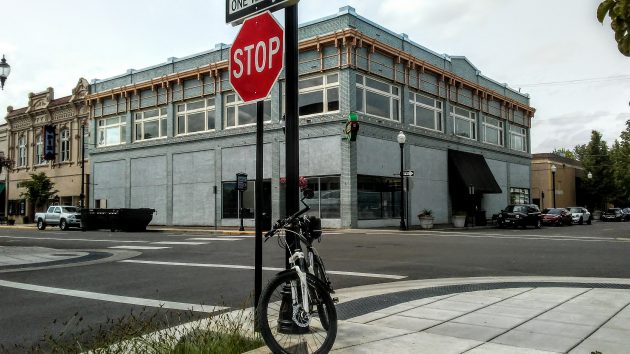
The historic S.E. Young & Son Building the way it looked in May. It’s to be completely restored.
The new owners of the S.E. Young & Son Building have planned a thorough restoration of what used to be a commercial anchor downtown, and they’ve asked Albany’s urban renewal district for help to complete the job.
Oscar and Tamalynne Hult, owners of The Natty Dresser men’s store, say they have raised more than a million dollars in bank and other private financing, and committed a chunk of their own savings. They figure the job will cost more than $1.4 million. And they’ve asked CARA, the Central Albany Revitalization District, for a grant of $259,000.
The grant would allow them to install a new elevator and restore the building’s original show windows facing Second Avenue. The windows on that side and on the side facing Broadalbin Street have been covered over for years. But on Broadalbin, the owners are restoring the windows on their own.
The request goes before the CARA Advisory Board when it meets — virtually and online only — at 5:15 p.m. Wednesday. The complete application, including financial details, can be found with the CARA agenda here.
Since it was built in 1912, the building, most recently Riley’s Bar and Grill, has housed clothing, furniture, and department stores including, for a time, Montgomery Ward’s.
The Hults’ plan is to have their clothing store on the main floor, open the basement as storage units for rent, and develop the upstairs for various potential uses as the market allows. For that, they consider a new elevator to be essential.
The city staff says the Hults’ planned revival of this building meets many of the CARA goals. As for me, I’d say that if they can do everything they hope, or most of it, this will be quite a dramatic improvement downtown. (hh)


$259,000 of public money handed out to a private, for-profit, local business interest.
To pay their debts, CARA skims money from the local taxing districts without their written permission and hands it out to local cronies.
Money that taxpayers approved for limited purposes (city’s general fund, Linn County, vet’s home in Lebanon, LBCC, state education fund through GAPS, ESD, and 4H.
CARA skims from 4H? Are you kidding me?
When local voters approved the tax rates for these specific, essential services, did voters give CARA permission to “siphon” (Hasso’s descriptor) some of the tax revenues away?
Of course not.
And back in 2000 the city council never asked voters to approve CARA’s formation. They simply forced it on Albany taxpayers by passing an ordinance.
But, hey, state law allows this kind of theft. And local cronies love the unearned money.
So, yeah, let’s ignore the (im)morality involved. It’s “free” money after all.
Just to be clear, the cash from what CARA borrows gets handed out to local cronies. To service the principal and interest on this debt, CARA skims money from the local taxing districts without their written permission.
Gordon, I disagree. The idea is that increased improvement in real market value levels which can be taxed above M5 and M50 assessed value limits, create higher tax revenue, the difference in improved value between the blighted property and the restored property, this difference is projected to service the debt. You can argue investment strategies, as historical tax freezes come off of improved properties, they should start returning revenue, CARA is a long term play. You can argue that CARA should have limits for non-profits that are not required to pay for services since they will not generate tax revenue, you can argue for shorter tax deferments, but the strategy is sound. A lot downtown has been rehabbed, now it’s up to the skill sets of individuals (not cronies) to use these tools to generate revenue to cover the community investment. One other indirect benefit is how it effects the community as a whole, does it create value to the surrounding community? Does it entice more people with resources to want to live here? I do agree that CARA should start publishing an income statement once the build out is complete so we can see what the actual ROI is, how much revenue the improvements are generating.
Steve—don’t bother to convince my friend Gordon about the niceties of money flow from CARA investments–he knows not only the goals but also the facts on the ground. We don’t have to wait to see how CARA investments are doing. The Albany area outside CARA has increased in value by 4X over CARA properties. CARA can’t be terminated until all it’s debts are paid—likely not in my lifetime. the whole system was designed to be corrupt and it is.
As for the July’s story at hand, a request from CARA. Like we didn’t see that coming?
Why are the expected benefits of the main floor retail and new restaurant/bar used to justify the $259K grant if it isn’t intended (or needed) for either of those things? If it’s being requested to enable development of the top floor and basement, the plans for those spaces should be fleshed out in the application and expected benefits quantified and considered separately.
Honestly, this application reads like the owners are highly leveraged from a very unfortunately timed business decision, and this grant is the contingency plan. Seems wildly inefficient and financially unwise to gift a quarter million dollars of taxpayer money to buy an elevator and some windows in hopes that it will result in economic development.
But, I’ve lived here long enough to know how these thing go.
Fixing up this building will be a great help for the City core.
It’s been an eyesore long enough, and drags down property values around it. Anything that can be done to restore it to usefulness is worth the money, if you ask me.